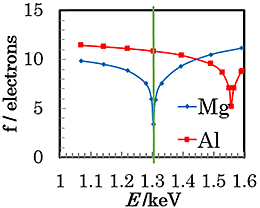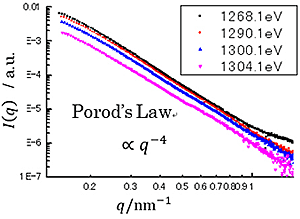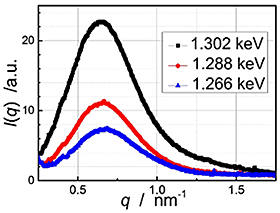As an extension of our previous study on anomalous small-angle scattering measurements at K absorption edge of aluminum[1], two dimensional anomalous small-angle X-ray scattering measurement (ASAXS) at the absorption edge of Mg has been successfully measured for Al-15 at%Mg alloys and MgO nanoparticles. Enhancement of contrast between Mg-rich precipitates and Al matrix was explained by anomalous dispersion of Mg, and anisotropic SAXS pattern agreed with the microstructure observed by TEM. Agreement of atomic scattering factor obtained from Al-Mg and MgO nanoparticles indicates that the origin of SAXS in the present Al-Mg alloys is Guinier-Preston zones, not the voids that grew from supersaturated vacancies or hydrogen atoms.
Controlling nanostructures undergoing phase transformation or self-organization processes is important to optimize their properties, not only for structural materials but also for functional materials. For light metal materials, Al- and Mg-based alloys with relatively small addition of solute elements have been developed for energy-efficient structural materials for transportation. However, weak contrast between Al and Mg, and lattice strain due to difference in the atomic size made characterization of the microstructure of such concentrated Al-Mg alloys difficult by conventional transmission electron microscopy (TEM) or hard X-rays, in particular, in the early stage of phase transformation. Small-angle X-ray scattering (SAXS) has been used to obtain quantitative information on the nanostructures as an averaged quantity over macroscopic volume, ranging from hard metallic materials to soft materials. Particularly the method is useful to obtain average nanostructural information for materials that are poorly ordered and have larger volume fraction, such as spinodally decomposed nanostructures and porous materials. However, the elements that we are interested in the present work, Mg and Al are neighboring elements, and the contrast between the Al matrix and Mg-rich precipitates is even weaker because the precipitates, i.e., the composition of GP zones or β” is assumed to be less than a quarter, Al3Mg for L12 ordered structure. Further, Al-Mg alloy often contains large amount of vacancies and hydrogen depending on the process history. Therefore, we need a method to identify the origin of the contrast. Such conditions are often encountered in examining advanced materials, for example, sulfur in Nafion® film, phosphorous in membranes. Anomalous small-angle X-ray scattering (ASAXS) enhances otherwise weak scattering contrast by choosing the photon energy close to the absorption edge of the element interest, and is also useful to discuss the origin of the contrast by examining the energy dependence of the contrast. In the present work, we demonstrate ASAXS results at lower side of the so-called tender X-rays region, where prevailing pixel detectors like Pilatus extended down to Si K edge, is still not available, for anisotropic samples. Figure 1 gives anomalous dispersion of the atomic scattering factors for Al, Mg, Si in the vicinity of K absorption edge of magnesium. As clearly seen in the figure, the atomic scattering factor of Mg decreased rapidly as the photon energy approaches to the absorption edge of Mg, showing much drastic contrast change than that shown for the elements having their K absorption edge in hard X-ray region. By tuning the photon energy slightly lower than the absorption edge, we can expect much higher contrast between the Mg rich precipitates (GP zones) and Al matrix. In the present work, we examined how quantitative our present SAXS measurements are, by checking energy dependence of SAXS intensity for Precipitation nanostructures in Al-Mg binary systems and MgO nanoparticles. The reason that we also chose to measure MgO nanoparticles is that energy dependence of the scattering contrast is expected to be the same for MgO and nanovoids, the latter being reported to be another scattering object often appear in Al-Mg alloys, particularly when cast or heat-treated under moisture.
Figure 2 shows ASAXS profiles from MgO nanoparticles. It is clearly seen that the scattering intensity, I(q), decreases as the incident photon energy approaches the absorption edge of Mg. This result agrees with the expected SAXS change because the origin of contrast is the difference in the scattering factors between vacuum and MgO, which decreases towards the edge as shown in Fig. 2. SAXS intensity from nanovoids is expected to behave similarly since the contrast should be between vacuum (or H2) and Al-Mg alloys. Figure 3 shows, in contrast, that the SAXS intensity increased as the energy approaches the Mg edge.
Present measurements at synchrotron radiation facilities have been performed under proposal numbers 2012g117, 2014G143 at PF and 2015B1438, 2016A1408 at SPring8, and supported by Grant-in-aid for scientific research from JSPS, 25286085 and by Light Metal Education Foundation.
REFERENCE[1] H. Okuda et al., J. Appl. Crystallogr. 49(2016)1803-1805.


